#watteau
Text

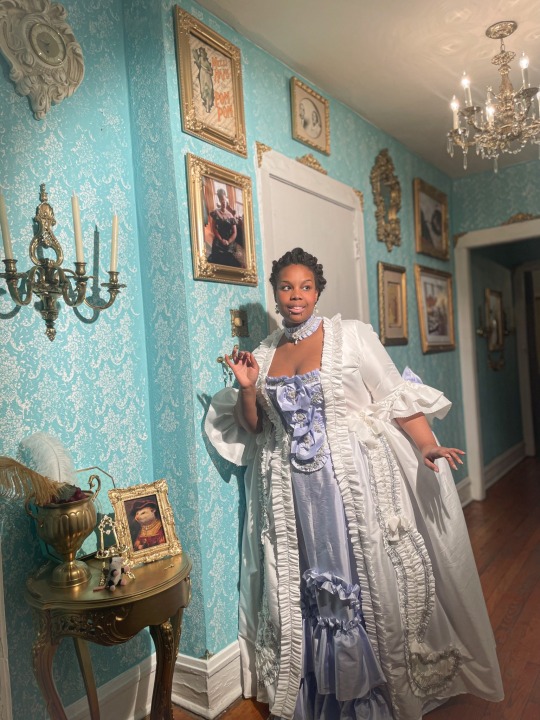
*a string quartet plays softly in the distance* | IG
#rococo#marie antoniette 2006#madame de pompadour#historical costume#historical clothing#robe à la française#baroque#watteau#fragonard#françois boucher#baby blue#pastel blue#mignonne#2022#pastel purple
2K notes
·
View notes
Text
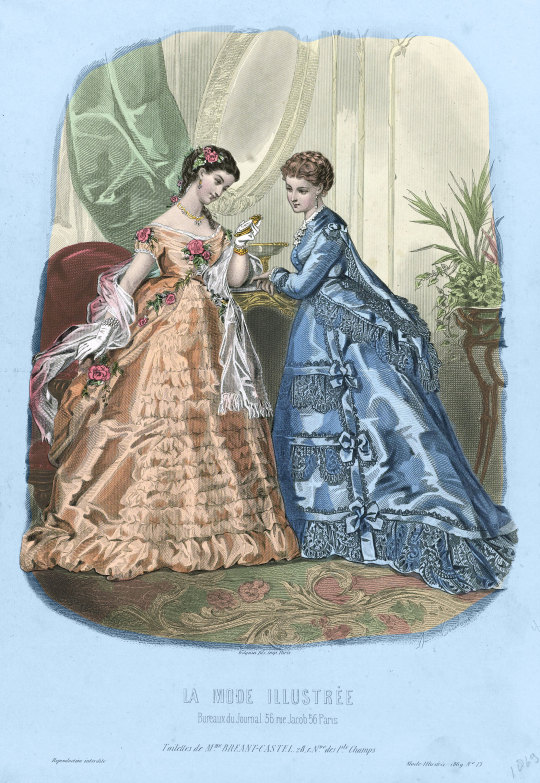
La Mode illustrée, no. 13, 28 mars 1869, Paris. Toilettes de Mme Bréant-Castel, 28, r. Nve. des Pts. Champs. Collection of the Rijksmuseum, Netherlands
Robe de dessous en satin mauve abricot. Robe de dessus en gaze de soie de même teinte, bordée d'un gros bouillonné. Le lé de devant est entièrement recouvert jusqu'à la ceinture par dix-sept petits bouillonnés, en même gaze. Corsage décolleté, orné, ainsi que les manches courtes, de branches de roses-thé; celles du corsage retombent jusque sur la robe, ornée plus bas d'une touffe de mêmes roses. Écharpe en tulle illusion blanc, garnie d'une frange en marabouts blancs. Coiffure en roses-thé.
Robe de faye bleue, bordée d'un large volant de dentelle noire, surmonté d'un biais en faye bleue ayant 4 centimètres de largeur; au-dessus du biais une dentelle noire étroite, posée debout. Un biais en faye bleue ayant 4 centimètres de largeur; au-dessus du biais une dentelle noire étroite, posée debout. Un biais pareil au précédent est posé sur chaque côté du lé de devant; il est orné de trois nœuds en faye, bordés de dentelle noire étroite. Le premier de ces nœuds est posé à la hauteur du biais inférieur; les deux autres à la hauteur des biais surmontant deux autres volants de dentelle noire, qui garnissent le lé de devant en tablier. Pouff en faye bleue garni de dentelle; le corsage montant à un pli Watteau.
—
Underdress in apricot mauve satin. Overdress in silk gauze of the same shade, edged with a large bubble wrap. The front strip is entirely covered up to the waist with seventeen small bubbles, made of the same gauze. Low-cut bodice, decorated, as well as the short sleeves, with branches of tea roses; those of the bodice fall down to the dress, decorated further down with a tuft of the same roses. White illusion tulle scarf, trimmed with a white marabou fringe. Tea rose hairstyle.
Blue faye dress, edged with a large black lace flounce, topped with a blue faye bias 4 centimeters wide; above the bias a narrow black lace, placed upright. A blue faye bias tape 4 centimeters wide; above the bias a narrow black lace, placed upright. A bias similar to the previous one is placed on each side of the front strip; it is decorated with three faye bows, edged with narrow black lace. The first of these knots is placed at the height of the lower bias; the other two at the height of the bias surmounting two other ruffles of black lace, which garnish the front strip like an apron. Blue faye pouff trimmed with lace; the bodice has a Watteau pleat.
#La Mode illustrée#19th century#1860s#1869#on this day#March 28#periodical#fashion#fashion plate#color#description#rijksmuseum#dress#gown#evening#Watteau#Modèles de chez#Madame Bréant-Castel
40 notes
·
View notes
Text

French Rococo Masters Part I
I'm back with a collection of paitings by four of the most iconic french rococo masters!
In addition to mythological depictions, rococo paintings often showed gallant or even frivolous scenes. Therefore, they were particularly suitable for private cabinets, where only the closest and most intimate friends were received.
I created the mesh and texture of the frame myself in Blender. There are 40 painting swatches in total by the following painters:
1-13 - François Boucher (1703-1770)
14-25 - Jean-Honoré Fragonard (1732-1806)
26-34 - Jean François de Troy (1679-1752)
35-40 - Antoine Watteau (1684-1721)
DOWNLOAD (SFS)
#sims#sims4#simscc#sims4cc#chateausims#historical#art#interieur#chateau#palace#rococo#painting#louisxv#boucher#fragonard#detroy#watteau
493 notes
·
View notes
Text

Watteau's statue in the Luxembourg Gardens in Paris
French vintage postcard
#luxembourg#tarjeta#postkaart#paris#gardens#sepia#historic#photo#postal#briefkaart#photography#vintage#ephemera#statue#ansichtskarte#old#postcard#french#postkarte#the luxembourg gardens#watteau#carte postale
13 notes
·
View notes
Photo

Seated Woman, Jean-Antoine Watteau, 1716-17
#seated woman#jean antoine watteau#jean-antoine watteau#watteau#1716#1717#1710s#1700s#18th century#rococo#drawing#art
150 notes
·
View notes
Photo

"Femme Assise" de Jean Antoine Watteau, circa 1720.
170 notes
·
View notes
Text

source: @saintinnocent
Jupiter and Antiope, by Watteau, circa 1714-1719. Louvre Museum, Paris.
8 notes
·
View notes
Text


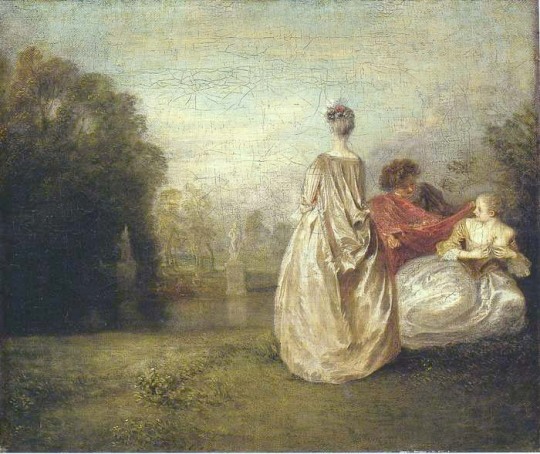
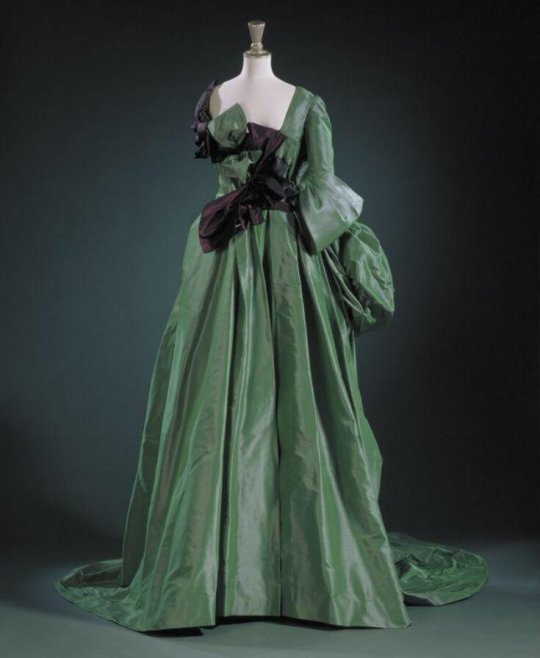
Fashion history repeats itself. Sack gown to Watteau pleats to modern deconstruction of the sack gown.
Image 1: 1760s-1770s sack gown. Back view showing the two double box pleats. Also called a sack-back gown, sacque, or robe à la française. This would have been worn over a pair of stays, and hoops or panniers to support the skirt.
Image 2: 1890s tea gown. Back view showing Watteau pleats. Unlike the 18th century sack, tea gowns were informal, at-home wear. The bodice of tea gowns was often boned and the linings were fitted, even though the outside looks loose and flowy. Theoretically tea gowns could be worn without a corset. But, people were wearing these to receive friends at their home for tea, and not wearing a corset would likely feel similar to going bra-less today. I personally would feel a little too exposed having friends over with no bra, even if I'm otherwise in comfy, informal clothes.
Image 3: The Two Cousins, 1716 painting by Antoine Watteau. Pleated or gathered backs were called Watteau pleats starting in the 19th century, taking inspiration from the sack gowns depicted in Watteau's paintings. No one in Watteau's time or the rest of the 18th century would have called them Watteau pleats or Watteau gowns.
Image 4: Watteau, 1996 Vivienne Westwood evening gown, inspired by 18th century sack gowns, but with modern elements like the asymmetry of the trimmings and side-hoop pouf. The description from the V&A says this gown has double box pleats in the back, like the 18th-century sack gowns, but weirdly, does not seem to have a view of this gown from the back.
#fashion history#v&a museum#victorian fashion#tea gown#19th century#18th century#19th century fashion#sack gown#watteau
8 notes
·
View notes
Text

Watteau Pitcher
Episode Four: Owl-stretching time
Wife
(Katya Wyeth) (bringing in a water jug and glass on a tray and laying it on his desk)
Watteau, dear?
Critic What a terrible joke.
Wife (Crying) But it's my only line!
#pun#sketch#Monty Python's#Flying Circus#Episode Four#Owl-stretching time#Watteau#art#Painting#Pitcher#Water#Drink
3 notes
·
View notes
Photo

📣 Le très beau numéro de Grande Galerie Le Journal du Louvre @museelouvre est disponible au Rayon Beaux-arts de la @librairie_mollat Au sommaire : un grand entretien sur les grands projets du Louvre avec Laurence des Cars, la restauration de La Mort de Sardanapale de Delacroix et de la Maestà de Cimabue, le portrait de grands mécènes du Louvre : Harry et Linda Fath et plein d’autres sujets passionnants encore comme le format perdu du Gilles de Watteau ou Feu ! Chatterton en résidence au Louvre… #grandegalerie #grandegalerielejournaldulouvre #lejournaldulouvre #delacroix #watteau #cimabue #feuchatterton #louvre #museedulouvre #librairie #mollat #bordeaux (à librairie mollat) https://www.instagram.com/p/CqLfzoDjlKi/?igshid=NGJjMDIxMWI=
#grandegalerie#grandegalerielejournaldulouvre#lejournaldulouvre#delacroix#watteau#cimabue#feuchatterton#louvre#museedulouvre#librairie#mollat#bordeaux
7 notes
·
View notes
Text

The history of the Gilles is as inscrutable as the expression on the clown's face. The picture is undated, no drawings exist, and it was never engraved. Compared with Watteau's habitual scale it is gigantic, and the handling is broad and matt. All these factors reinforce something suggested by the subject matter––namely, that it was probably a theater billboard, painted for one of those small French companies which set up in emulation of the Italians. Although they followed the main outline of the Commedia dell'Arte repertory, the French players created variations of their own, including a character named Gilles, a modification of the original Pierrot, whose existence is first noted in 1695. The character, whose final incarnation was as Pagliacci, was the natural unfortunate of the troupe, the butt of its most brutal comic sallies, but protected by an armour of innocence which was eventually seen to triumph. To the keen appetites of the eighteenth-century audience the whole point of Gilles was his thick-headedness, his ability to resist instruction. In a popular performance attempt would be made to knock some sense into him; he would be giving a dancing master, a fencing master, a drawing master––all to no avail. At this point of the action a donkey would be led across the stage to underline his ineffable stupidity. This is the moment painted by Watteau. But as well as recording a moment of theatrical history, Watteau has again given the situation a colouring of his own. For his Gilles belongs in a more contemplative setting than that of the knockabout farce. The impassivity of the face suggests that the ability to survive continuous if light-hearted cruelty is not only potentially tragic but at all times heroic. This is a concept worthy of Watteau, who has given rise to comments, from Voltaire among others, that he never painted anything serious. The Gilles is not only one of the most serious pictures to be painted in the eighteenth century, it is perhaps the most truly personal of all Watteau's works.
anita brookner, watteau, 1967
#anita brookner#watteau#texts#18#surviving continuous if light-hearted cruelty as not only tragic but at all times heroic = anita brookner's 1983 novel look at meeee
5 notes
·
View notes
Text

La Mode illustrée, no. 12, 21 mars 1869, Paris. Robe de chambre Watteau (devant et profil).
Cette robe de chambre peut être faite en toute étoffe: en tartan, flanelle, cachemire, percale, suivant les saisons; notre modèle est fait en cachemire nuance feutre, garni de bandes dentelées et de revers en cachemire rouge; des rouleaux de satin, des boutons et de la frange complètent cette garniture.
This dressing gown can be made of any fabric: tartan, flannel, cashmere, percale, depending on the season; our model is made in felt-tone cashmere, trimmed with jagged bands and red cashmere cuffs; satin rolls, buttons and fringe complete this trim.
#La Mode illustrée#19th century#1860s#1869#on this day#March 21#periodical#fashion#fashion plate#description#Forney#dress#dressing gown#collar#Watteau
21 notes
·
View notes
Photo
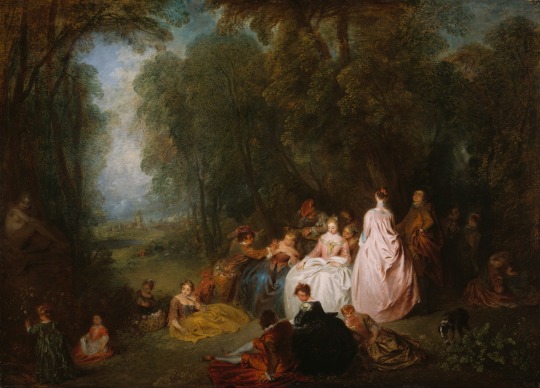
Jean-Antoine Watteau, Fête Champêtre (Pastoral Gathering), ca. 1718-21, oil on panel, 48.6 × 64.5 cm, Art Institute Chicago.
9 notes
·
View notes
Text

US Vogue December 1950 ❤️❤️❤️❤️❤️
Mrs Jayne Wrightsman, wife of Mr Charles Wrightsman, wears here a Watteau satin coat, ice blue, new in its sumptuous length, its high mink collar; on a ball gown of the same satin. designed for her.
Mme Jayne Wrightsman, épouse de Mr Charles Wrightsman, porte ici un habit de satin Watteau, bleu glacier, neuf dans sa longueur somptueuse, son haut col de vison ; sur une robe de bal du même satin. conçue pour elle.
Photo Horst P. Horst
vogue archive
#us vogue#december 1950#fashion 50s#1951#spring/summer#printemps/été#evening set#tenue de soirée#jayne wrightsman#watteau#socialite#mondaine#horst p. horst
4 notes
·
View notes
Photo

Studies of Three Women, Jean-Antoine Watteau, 1716-17
#studies of three women#jean-antoine watteau#jean antoine watteau#watteau#1716#1717#1710s#1700s#18th century#rococo#drawing#sketch#study#art
158 notes
·
View notes
Text
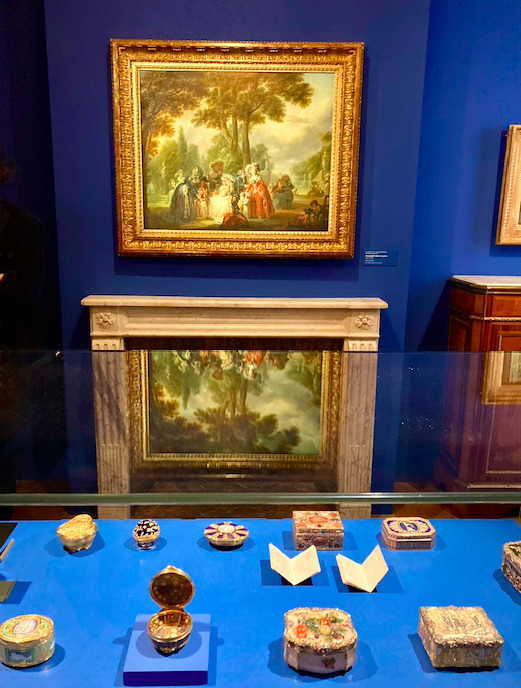
"Assemblée dans un Parc" de François-Louis-Jospeh Watteau, dit Watteau de Lille (circa 1785) à l'exposition "Luxe de Poche - Petits Objets Précieux au Siècle des Lumières" au Musée Cognacq-Jay, avril 2024.
2 notes
·
View notes